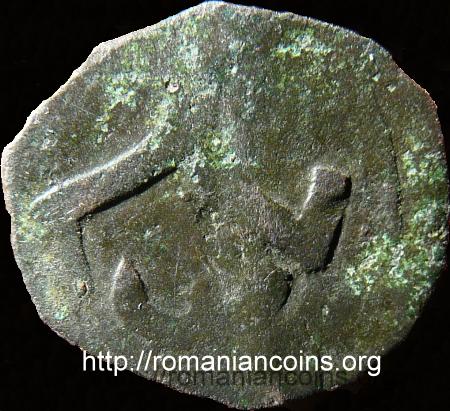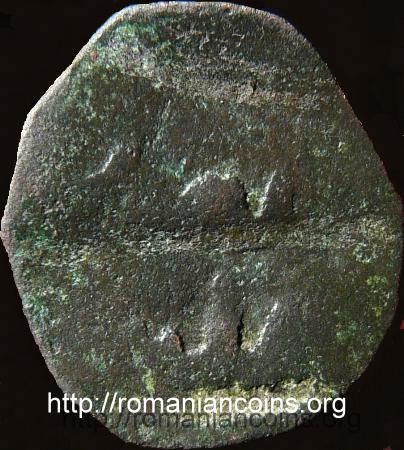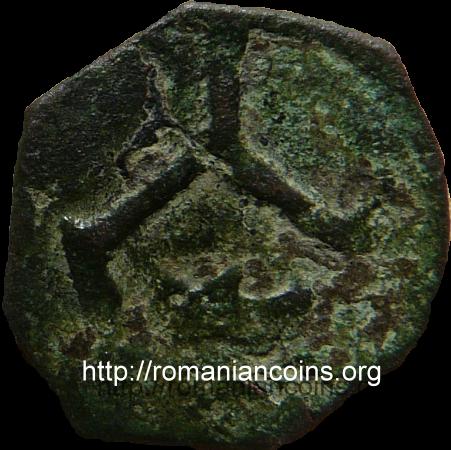
|
Costeşti-Gîrla - Tatar coins from Moldavia |
|

|

|

|

|
|
rough diameter 14-17 mm, ~0.8 g, AE Obverse tamga and pseudo-inscription - maybe Arabic letter س (sin) or maybe ع (ayn) rotated, outer linear circle | Reverse corrupted inscription (pseudo-inscription) written on two rows, outer linear circle |
About the Village of Costeşti
Costeşti is a village in the Ialoveni raion of Republic of Moldova [former judeţ of Lăpuşna], mentioned for the first time in a document from 1573, during the rule of John Voivod the Frightful. The village of Gîrla, nowadays a part of Costeşti village, was mentioned for the first time in 1724. In 1959 13 unusual coins, of two types, were discovered here. Published in 1969, these coins were later referred as Costeşti-Gîrla coins, or Costeşti coins only.
About Costeşti-Gîrla Coins
The Costeşti-Gîrla coins were classified into two main types, one with tamga (the tamga is quite resembling the tamga used on the Tatar coins struck by the khans of Crimea) and with pseudo-inscription, and one with corrupted inscriptions on both faces (rarer and considered to be of double weight). Type I pieces are thin, sometimes having polygonal shape, were struck on copper sheet, and weigh about 0.8 grams [3]. It is likely that the unknown issuer intended to strike coins weighing one danik (or dannik). One danik is one sixth of a miskal (dirham, dirhem), and the dirhem has about 70 grains. One grain has 0.0647989 g, so the mass of a danik was about 0.78 g [1]. The heavier pieces, of type II, of about 1.57 g [3], could be 2 daniks of copper. After [2], all Costeşti-Gîrla pieces represented copper puls - the regular Tatar copper coin.
The tamga is an emblem used by Huns, Mongols, Turkic peoples etc.). The tamga appearing on the Tatar coins struck in Crimea is the stylized representation of the trident of Hadji I Giray, founder of the Crimean Khanate and descendant of Genghis Khan. The tamga used on Costeşti-Gîrla coins is like an triskelion, but one arm is not bent. The triskelion is a motif comprising three human legs bent from knee (otherwise, it means three legs in Greek), or three spirals. Taking into account the formal aspect of the inscriptions, the straight arm is - by convention - directed to the top of the coin [2], [3].
Such coins were also unearthed at Orheiul Vechi (Old Orhei), at Cetatea Albă (White Fortress) and at Hansca (not far from Costeşti). The coins are not like the usual coins of the Golden Horde, so they are not medieval fakes. Today it is accepted that the Costeşti-Gîrla coins are local issues struck by a local Tatar ruler in the style of Golden Horde coins. These coins were struck in the 14th century, very likely between 1359 and 1363; the mint itself could have been at Costeşti or maybe at Cetatea Albă. These are the oldest medieval coins struck on Moldavian territory.
The Costeşti-Gîrla coin are full of mistery, and they are still very little (and very incomplete incomplet) known today.
References
1. Fedorov-Davîdov G., The Monetary System of The Golden Horde. http://www.paleog.com/im/fd/summary.pdf, accessed on February 2012.
2. Khromov K., The Successors of Chingiz Khan and their Coins. http://www.hordecoins.folgat.net/S_galGH_costashti.htm, accessed on February 2012 (August 2015, dead link).
3. Nicolae E., Monedele de tip Costeşti-Gârla. (Coins of Costeşti-Gârla Type) Simpozion de numismatică dedicat centenarului Societăţii Numismatice Române, Chişinău, noiembrie 2003. Comunicări, studii şi note. Ed. Enciclopedică, Bucureşti, 2005, p. 89 ... 104
|
Back to selection page!
|